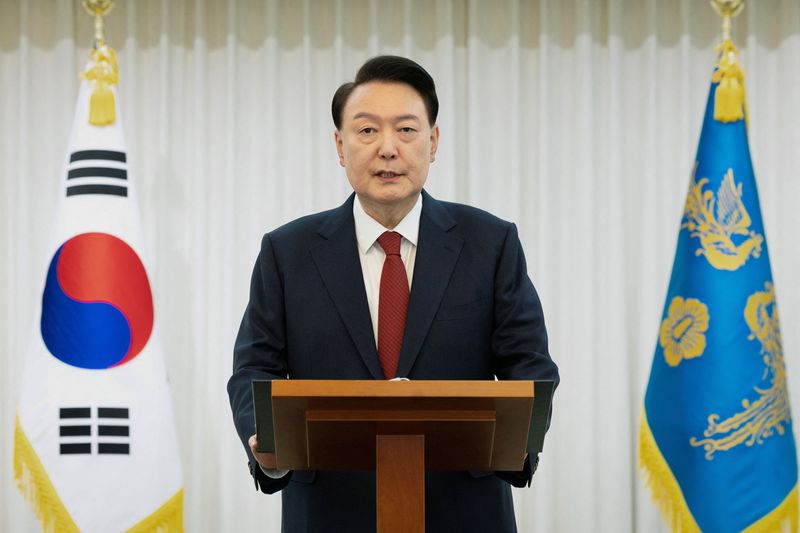SEOUL (Reuters) – South Korean President Yoon Suk Yeol’s impeachment on Saturday, suspending him from his official duties, capped 11 days of political disaster that roiled his nation, sparked by his shock resolution to impose martial legislation.
Listed here are key occasions from martial legislation to impeachment:
-Dec. 3: Shortly earlier than 10:30 p.m. (1330 GMT), Yoon declares on nationwide tv he’s imposing martial legislation to root out “anti-state forces” and overcome political impasse.
An hour later the army points a decree banning exercise by political events and lawmakers, and troops and police descend on the opposition-controlled parliament. Staffers use barricades and fireplace extinguishers to push back particular operations troopers who arrive by helicopter and break home windows as they enter parliament.
Lawmakers hop fences to keep away from the safety cordons and crowds of protesters collect.
-Dec. 4: Defying the army’s order, 190 lawmakers within the early hours unanimously vote to reject Yoon’s declaration and troops start to go away.
About three and a half hours later, Yoon provides one other televised speech, saying he’s lifting martial legislation. The decree was in impact for about six hours.
Opposition events submit movement to question Yoon.
U.S. Deputy Secretary of State Kurt Campbell says Yoon “badly misjudged” his resolution to declare martial legislation, which was “deeply problematic” and “illegitimate.”
-Dec. 5: Yoon’s Folks Energy Occasion, though divided, decides to oppose his impeachment.
Yoon accepts the resignation of Defence Minister Kim Yong-hyun. Police examine Yoon, Kim and the inside minister on accusations of treason and associated crimes over the declaration of martial legislation after opposition events and activists filed complaints.
-Dec. 6: PPP chief Han Dong-hoon says Yoon have to be faraway from energy for making an attempt to impose martial legislation. Some social gathering members urge Yoon to resign.
-Dec. 7: Yoon addresses the nation to apologise, saying he’ll put his destiny within the arms of the PPP however not saying he’ll resign.
A vote to question Yoon fails because the PPP boycotts, depriving parliament of a quorum.
-Dec. 8: Prosecutors identify Yoon as the topic of a legal investigation over the martial legislation try. Ex-Defence Minister Kim is arrested.
-Dec. 9: The justice ministry bars Yoon from leaving South Korea.
-Dec. 10: Kwak Jong-geun, commander of the Military Particular Warfare Command, tells a parliamentary committee that Yoon gave an order to “drag out” lawmakers from parliament after declaring martial legislation.
Yoon’s workplace says it has “no official position” on who’s working the nation amid questions over PPP discussions for a caretaker authorities.
Ex-Defence Minister Kim makes an attempt suicide.
-Dec. 11: Police attempt to search Yoon’s workplace however are blocked from getting into the constructing.
-Dec. 12: Yoon says in one other televised speech he’ll “fight to the end”, alleging North Korea had hacked South Korea’s election fee and expressing doubt over his social gathering’s landslide election defeat in April. The Nationwide Election Fee denies the declare.
Seven PPP members declare their intention to help impeachment, one in need of the quantity wanted for the movement to move.
-Dec. 13: Opposition chief Lee Jae-myung calls on PPP members to “join and vote yes for impeachment”.
-Dec. 14: Parliament impeaches Yoon with the help of 204 of the 300 lawmakers within the one-chamber parliament. At the very least 12 PPP members vote to question.

Yoon’s presidential powers are suspended, and Prime Minister Han Duck-soo turns into appearing president.
The Constitutional Courtroom receives parliament’s impeachment declaration. It would have six months to resolve whether or not to take away or reinstate him.




